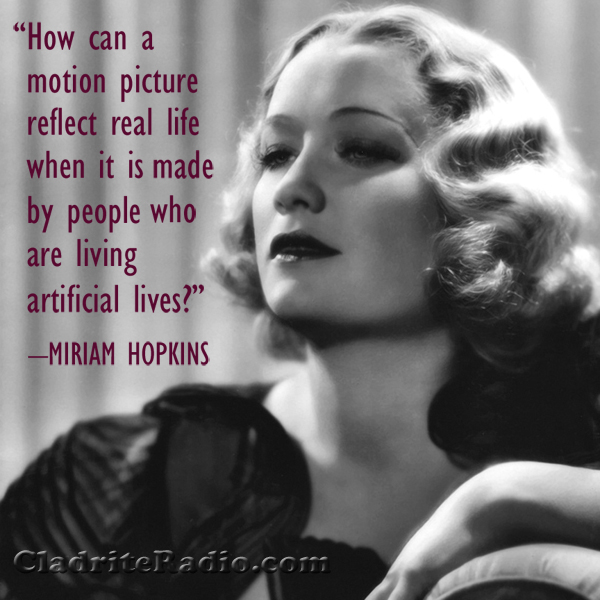Here are 10 things you should know about Lowell Sherman, born 134 years ago today. The actor and director died far too young, but he left an enduring legacy both in Hollywood and on Broadway.
Tag: Becky Sharp
10 Things You Should Know About Miriam Hopkins
Here are 10 things you should know about Miriam Hopkins, born 119 years ago today. She was the kind of larger-than-life diva we seldom see on the silver screen today.
Happy Birthday, Miriam Hopkins!
Ask the average man or woman on the street about Miriam Hopkins, who was born 113 years ago today in Savannah, Georgia, and you’ll likely receive a blank stare. But movie buffs well recall her many standout performances.
Hopkins had what TCM.com has described as “an intriguing, husky voice and a brittle, sometimes twitchy yet sexy style.” And like Bette Davis, with whom she was reputed to have had a long-running feud, she was as much a character off the screen as on it.
Hopkins frequently returned to the stage, where her career had begun, when things slowed down for her in Hollywood, and in 1933, she originated the lead role of Julie in Jezebel on Broadway. The play didn’t do particularly well, but when Warner Brothers sought the rights to the play, of which Hopkins was part-owner, for a film adaptation, Hopkins demanded she be cast as Julie before she would agree to the deal. After receiving assurances that she would, in fact, portray Julie in the film, Hopkins signed off the deal, only to see Davis be given the role instead. And worse, Davis went on to win an Oscar, her second, for her work in the film. That didn’t set well with Hopkins.
In 1938, Hopkins and Davis were paired in a film, The Old Maid (1939, based on an Edith Wharton story), and on the first day of shooting, Hopkins got Davis’s goat by showing up in a dress that was a duplicate of one Davis had worn in Jezebel.
Davis wrote of Hopkins’ work in The Old Maid, “Miriam used and, I must give her credit, knew every trick in the book. I became fascinated watching them appear one by one…When she was supposed to be listening to me, her eyes would wander off into some other world in which she was the sweetest of them all. Her restless little spirit was impatiently awaiting her next line, her golden curls quivering with expectancy.”
Among the memorable pictures that stand out in Hopkins’ career are some true classics: The Smiling Lieutenant (1931), Design for Living (1933) and Trouble in Paradise (1932) for director Ernst Lubitsch, Rouben Mamoulian’s Dr. Jekyll and Mr. Hyde (1931), and a picture that is considered among the most memorable of pre-codes, The Story of Temple Drake. She also starred in Becky Sharp (1935), the first three-strip Technicolor feature.
Happy birthday, Ms. Hopkins, wherever you may be!
The slow rise of color
We sometimes scratch our heads over how long it takes new technology to come into wide use.
For instance, did you know that a working fax machine was introduced to the general public at the 1939 World’s Fair in New York City, and that the earliest efforts in transmitting images date back to the 19th century? We can see why it took so long to perfect, but one can’t but wonder what took so long for it to be widely adopted, once it had been.
Similarly, the vast majority of pre-1950 movies were in black and white, so who would have guessed that experiments in using color dated all the way back to the early twentieth century?
Here’s a reel of tests of Kodachrome color motion picture film from 1922. from 1922, featuring actresses Mae Murray, Hope Hampton, and Mary Eaton, among others. Color film tehnology was two-color, then—reds and greens—so it’s not the full, vivid color that would come later, but it’s got charms of its own.
Oh, and that inexplicable delay I mentioned above? It occurred in this case, too: It would be 13 years after this footage was shot before the first full-length color feature, Becky Sharp, was released.
![]()

